- As you have seen, the "Stop-and-Wait" is waiting too long
for ACKs in high speed links and is thus wasteful of bandwidth.
- A second type of methods overcome this problem by sending
a batch of frames without waiting for ACK from the receiver.
- This type of scheme is called
Automatic Retransmission reQuest
or ARQ
These schemes use a "sliding window" to determine the validity of the frames.
- A very important ARQ protocol is the Go-Back-N method which we will study below.
- A window is a
consecutive range of sequence number
(that will be used the sender or receiver)

- The sender uses a number in the
sender window to label a frame
- The receiver uses the range of numbers
to determine if a frame is acceptable.
- Size of the range of numbers used by the sender is called the Sender Window Size (SWS)
- Size of the range of numbers used by the sender is called
the Receiver Window Size (RWS)
- Note: it will help to understand the sliding method that you
know the fact that:
- Initially, the sender and receiver window will have the same starting
number (lined up)
- Sender Window Size and Receiver Window Size may be different
- Certain event(s) will cause the sender/receiver to "slide"
its window forward (but never backwards !) -- these events will
be discussed below...
- The receiver window will always be (1) lined up or (2) ahead of the sender window. But the receiver window will NEVER be behind the sender window; because this situation will never allow the receiver window to ever slide forward....
- Initially, the sender and receiver window will have the same starting
number (lined up)
For now, assume we can use an infinite number of sequence numbers (understand the baiscs of the method first)
As we have discovered, both frames and ACK must be numbered by sequence numbers to be of any use.
Because the sliding window method will allow the sender to transmit multiple frames before receiving an ACK, we can define 2 ACK processing methods in sliding windows:
- Selective ACK
- The ACK N message acknowledges only the frame with sequence number N
- Cumulative ACK
- The ACK N message acknowledges all frames with sequence number <= N
- The cumulative ACK scheme has a built-in
error recovery: when ACK N is lost but ACK N+1 is
received, the sender can know that frame N was received.
ACK message loss is very serious, and to improve reliability, cumulative ACK method is preferred in a high error rate environment.
- The sliding window method using cumulative ACK is known as the Go-Back-N ARQ protocol.
- When sender has a new frame to transmit and there is some unused
sequence number in sender window, use the next sequence number
and send new frame labeled with that number.
Always set timeout for a transmission (new or re-transmission)
- Note: if sender does not have any new frame to send, we don't need to
do anything, that's trivial.
- If sender has some new frame to send but there is no unused
sequence number in the sender window, the sender must wait
until a new number becomes available !
- One of two things will happen while sender waits:
- Receives an ACK X frame
- Slide the sender window so that the left end of the sender window is X+1 (keep the same sender window size !)
Example: (here: X = 2)
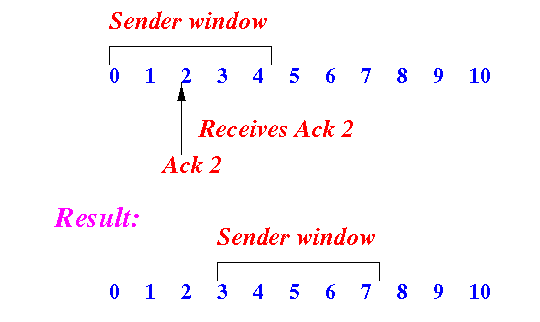
- Timeout on some frame:
- Retransmits the frame (with same sequence number) and set another timeout.
- Receives an ACK X frame
- Suppose the receiver window is [n, n+k]
- When receiver receives a frame that has a sequence number
within the Receive Window range, the receiver accepts
the frame, and otherwise, the receiver rejects
the frame.
- The receiver will buffer only the accepted frames.
The accepted frames will only be delivered when it is possible to deliver the frames in sequence.
- (As in Stop-and-wait) the receiver must send
an ACK X message back to the sender
(for the same reason: one or more of receiver's ACK messages
may have been lost).
But what must the value X be ??? The value for X must be the largest sequence number so that
- it acknowledges all those frames that were received and
- it must NOT cause the sender to misunderstand that a missing frame has been received (this will cause the sender to NEVER transmit a missing frame and cause an unrecoverable error).
- Example 1:
- Suppose the receiver window is 0, 1, 2,..., 5.
- Suppose the receiver received frames 0, 1 and 3.
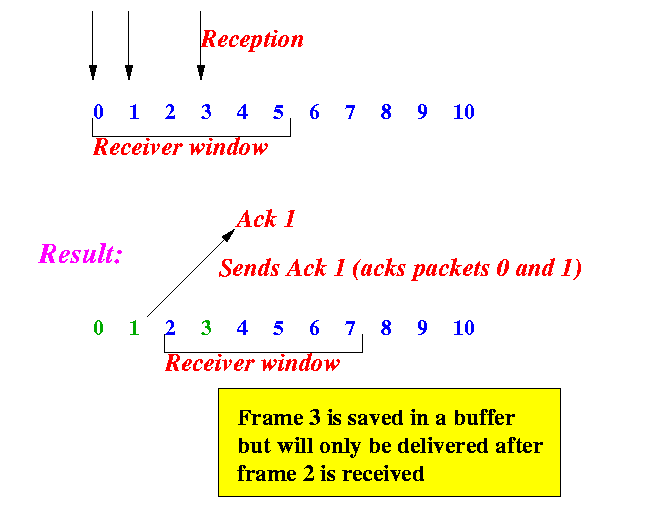
- Suppose the receiver window is 0, 1, 2,..., 5.
- Example 2:
- Suppose the receiver window is 0, 1, 2,..., 5.
- Suppose the receiver has received frames 1 and 3.
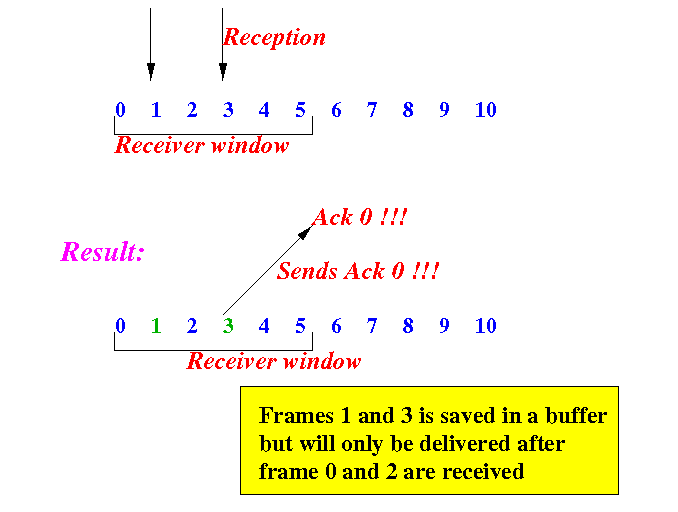
- Suppose the receiver window is 0, 1, 2,..., 5.
- So, to determine X, the receiver must check
if the frame whose sequence number is equal to
the first position in its receive window was received.
If the first expected frame in receive window was NOT received, the receiver returns ACK n-1
Otherwise, the receiver determines the first missing frame in the receiver window, say this frame is number n+x. The receiver will return ACK n+x-1
We will look at some examples of the operation of the Go-Back-N protocol before showing that it is correct
- Notice how the sender and receiver windows change.
- Specifically: notice how a sequence number is always removed the receiver window first, before it is removed from the sender window

|
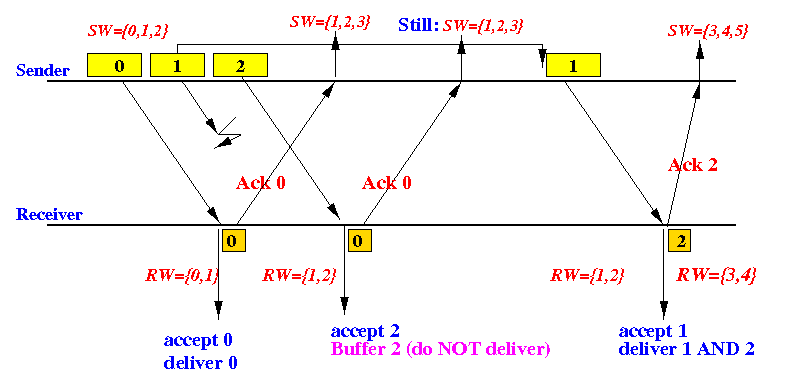
|
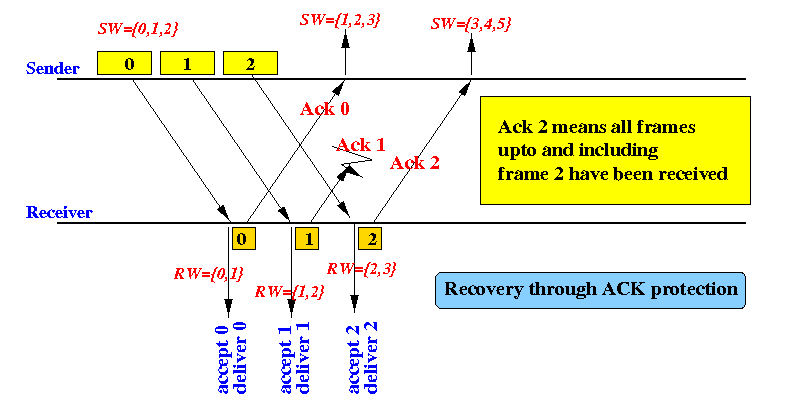
|
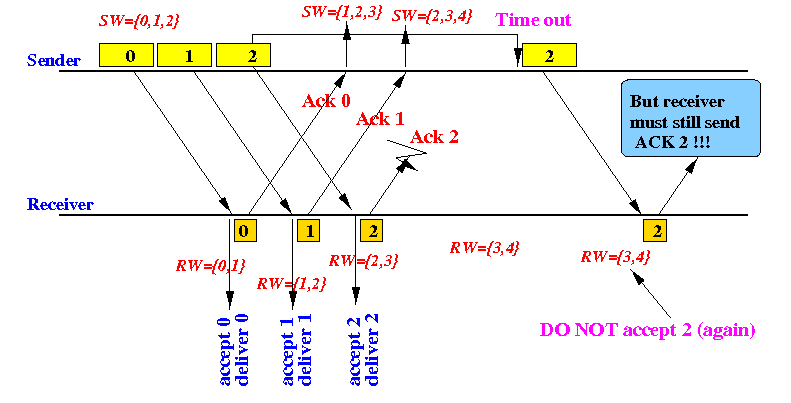
|
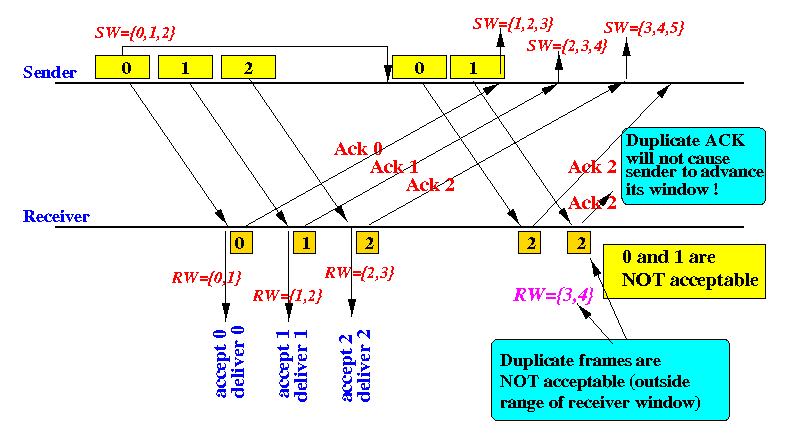
|
- Claim:
The Go-back-N protocol using infinite set of sequence numbers can ensure that the receiver accepts each frame exactly once and in the right order. Bold statement, someone may ask you to proof it....
This statement can be proven by the following facts:
- Fact: all the frames that are received will be delivered
in the correct ordering
This is trivially when we have an infinite number of sequence numbers.
That is because the sender can number each frame in the order sent (and will not run out of sequence numbers)
The frames received by the receiver can always be arranged in the correct order by looking at the sequence number.
Frames that have the same sequence numbers are always duplicate frames.
Therefore, the receiver will be able to deliver the received frames excatly once and in the correct ordering.
- A frame with sequence number X will (eventually)
be received at least once .
This fact is proved by observing how the sender and receiver windows moves:
- The sequence number X will exit sender's window
only when Ack X (or some Ack that includes Ack X)
is received.
- The receiver will only send Ack X after the frame X has been received.
Example:
- Initially, sequence number 0 are in both sender and receiver window:

- Sequence number 0
cannot exit
the sender window before the receiver windows -
e.g., this situation is
impossible :

because the receiver can never have sent ACK 0 (because receiver window will slide when it sents ACK 0)!!!
Because a (any) sequence number X exits the receiver's window before it exits the sender's window, the frame with that sequence number must have been received at least ONCE
- The sequence number X will exit sender's window
only when Ack X (or some Ack that includes Ack X)
is received.
- A frame with the sequence number X will
not be accepted
more than once by the receiver
This follows directly from (1) above.
- Fact: all the frames that are received will be delivered
in the correct ordering
- Therefore, the frame with sequence number X will be accepted exactly once (and in the right order)